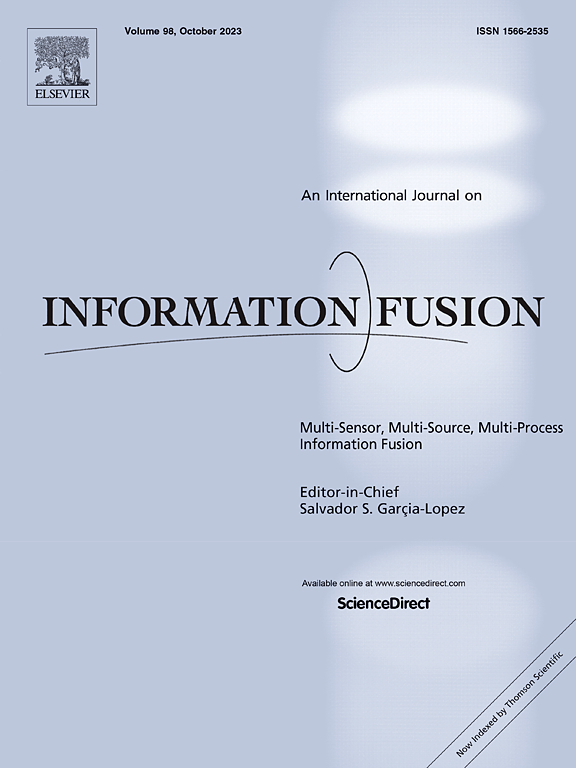Triplets-based large-scale multi-view spectral clustering
IF 14.7
1区 计算机科学
Q1 COMPUTER SCIENCE, ARTIFICIAL INTELLIGENCE
引用次数: 0
Abstract
By integrating complementary information from multiple views to reach consensus, graph-based multi-view clustering describes data structure competently, thereby attracting considerable attention. It is time-bottlenecked by graph construction and eigen-decomposition in the big data era. Existing methods usually utilize anchor graph learning to address this issue. However, problems of unsupervised representative anchor selection, consensus or view-specific anchors, anchor alignment, etc., remain challenging. Moreover, excessive information is discarded for the sake of efficiency. Motivated by the essence of the anchor-based methods that utilizing representative point-to-point relations to reduce graph complexity, we generate triplets for each view based on neighborhood similarity to preserve point-to-point relations and local structure, and propose triplets-based large-scale multi-view spectral clustering (TLMSC). Subsequently, the triplet enhancement strategy is designed to select representative triplet relations to improve efficiency and clustering performance. Specifically, positive examples of triplets are filtered according to the view consensus to significantly increase the probability of positive examples belonging to the same cluster. The most indistinguishable hard negative examples are generated based on probabilities to improve discrimination performance. Guided by the enhanced triplets and its weights, an improved low-dimensional embedding is constructed through optimization, which further serves as an input to the proposed fast sparse spectral clustering (FSSC) to obtain clustering results. Numerous experiments validate the efficiency and superior performance of the proposed TLMSC. An average improvement of 12.25% at least in ACC compared to 10 state-of-the-art methods on 18 datasets. The code is available at github.com/ytccyw/TLMSC.
基于三重体的大规模多视点光谱聚类
基于图的多视图聚类通过整合来自多个视图的互补信息来达成共识,很好地描述了数据结构,因此备受关注。在大数据时代,图的构造和特征分解是时间瓶颈。现有的方法通常利用锚图学习来解决这个问题。然而,无监督代表性锚点选择、共识或特定视图锚点、锚点对齐等问题仍然具有挑战性。此外,为了效率,过多的信息被丢弃。基于锚点方法利用代表性点对点关系降低图复杂度的本质,基于邻域相似性为每个视图生成三元组,以保持点对点关系和局部结构,提出了基于三元组的大规模多视图谱聚类方法(TLMSC)。然后,设计三元组增强策略,选择具有代表性的三元组关系来提高效率和聚类性能。具体而言,根据视图共识对三元组的正例进行过滤,显著提高了正例属于同一聚类的概率。基于概率生成最难以区分的硬负例,以提高判别性能。在增强的三元组及其权值的指导下,通过优化构建改进的低维嵌入,并将其作为快速稀疏谱聚类(FSSC)的输入,获得聚类结果。大量实验验证了所提出的TLMSC的效率和优越的性能。与10种最先进的方法在18个数据集上相比,ACC的平均改进至少为12.25%。代码可在github.com/ytccyw/TLMSC上获得。
本文章由计算机程序翻译,如有差异,请以英文原文为准。
求助全文
约1分钟内获得全文
求助全文
来源期刊

Information Fusion
工程技术-计算机:理论方法
CiteScore
33.20
自引率
4.30%
发文量
161
审稿时长
7.9 months
期刊介绍:
Information Fusion serves as a central platform for showcasing advancements in multi-sensor, multi-source, multi-process information fusion, fostering collaboration among diverse disciplines driving its progress. It is the leading outlet for sharing research and development in this field, focusing on architectures, algorithms, and applications. Papers dealing with fundamental theoretical analyses as well as those demonstrating their application to real-world problems will be welcome.
 求助内容:
求助内容: 应助结果提醒方式:
应助结果提醒方式:


